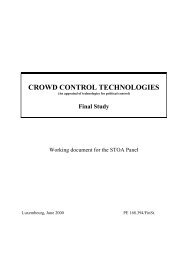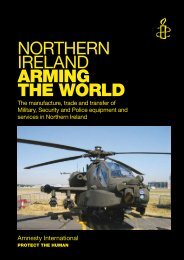Download Stopping the Torture Trade - Omega Research Foundation
Download Stopping the Torture Trade - Omega Research Foundation
Download Stopping the Torture Trade - Omega Research Foundation
You also want an ePaper? Increase the reach of your titles
YUMPU automatically turns print PDFs into web optimized ePapers that Google loves.
<strong>Stopping</strong> <strong>the</strong> torture trade<br />
6<br />
They were extremely painful as <strong>the</strong>y were worn without<br />
shoes and socks, and used to cut into my skin and leave<br />
scars which lasted for months.”<br />
In a diary he smuggled out of prison in cigarette packets,<br />
Patrick Foster recorded his surprise that <strong>the</strong> chains in which he<br />
was held were made in England:<br />
“<strong>the</strong> shackles and cuffs in this establishment, as in every<br />
o<strong>the</strong>r incidentally, were both made by Hiatt in England;<br />
somewhat ironic...” 3<br />
In January 1995, in response to Patrick Foster’s allegations, a<br />
Hiatts director stated:<br />
“We’ve stopped making leg cuffs and those were dispatched<br />
as hand cuffs... I don’t have to dictate or tell<br />
anybody what to do with <strong>the</strong> tools <strong>the</strong>y get. That’s not my<br />
problem, <strong>the</strong>y do exactly as <strong>the</strong>y like.”<br />
However in 1995 researchers bought legcuffs which were<br />
stamped “Hiatts” and “Made in England” from a US-based<br />
distributor, Hiatt-Thompson. Patrick Foster confirmed that <strong>the</strong>y<br />
were identical to <strong>the</strong> ones which were used on him. It would<br />
appear that Hiatts had been exporting oversized handcuffs from<br />
<strong>the</strong> UK to <strong>the</strong> USA where Hiatt-Thompson would add longer<br />
chains to turn <strong>the</strong>m into legcuffs; <strong>the</strong> sale and export of legcuffs<br />
are still legal in <strong>the</strong> USA.<br />
On 28 July 2000, UK Foreign Office Minister Peter Hain<br />
announced <strong>the</strong> introduction of new controls on <strong>the</strong> export of<br />
individual “oversize” bracelet cuffs so that <strong>the</strong>y cannot be used<br />
for leg irons or legcuffs. AI welcomes this statement, but <strong>the</strong><br />
Hiatts case illustrates how easily export controls can be evaded<br />
and underlines <strong>the</strong> need for transparency and accountability.<br />
The case of <strong>the</strong> Spanish arms manufacturing company<br />
Larrañaga y Elorza highlights <strong>the</strong> urgent need to introduce<br />
controls which cover <strong>the</strong> whole of <strong>the</strong> European Union (EU). For<br />
<strong>the</strong> past 10 years Larrañaga y Elorza has specialized in<br />
manufacturing restraint devices and irons. 4 Tomás Astigarraga,<br />
<strong>the</strong> company’s Export Manager, was quoted in <strong>the</strong> Spanish<br />
newspaper El País5 as saying that <strong>the</strong> main customers of <strong>the</strong><br />
irons manufactured by Larrañaga y Elorza were <strong>the</strong> USA and<br />
some countries in South America. He told <strong>the</strong> newspaper that




